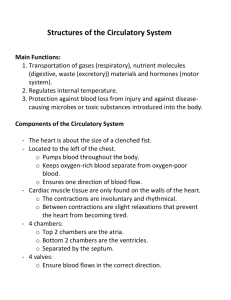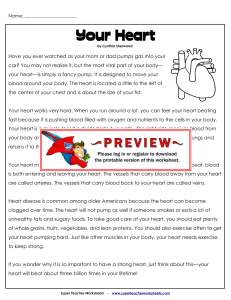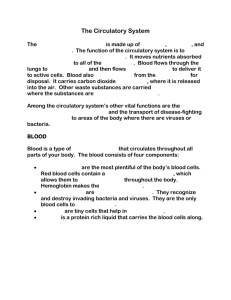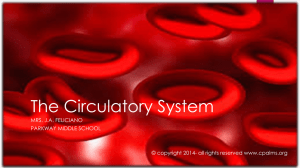PDF - Science Matters
advertisement
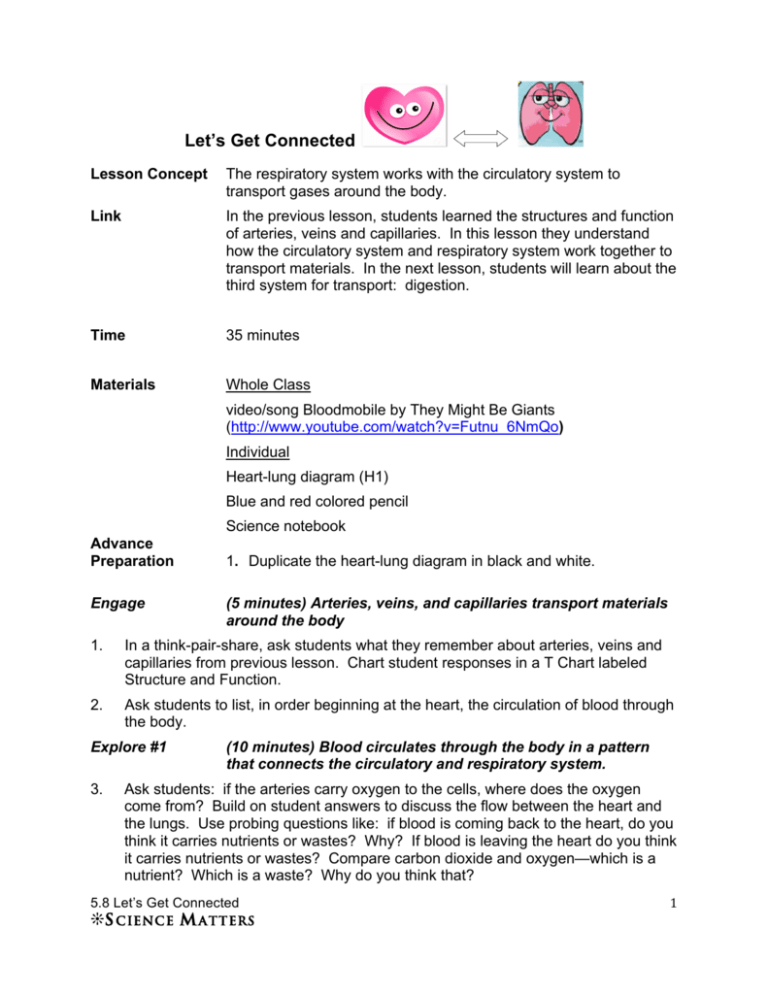
Let’s Get Connected Lesson Concept The respiratory system works with the circulatory system to transport gases around the body. Link In the previous lesson, students learned the structures and function of arteries, veins and capillaries. In this lesson they understand how the circulatory system and respiratory system work together to transport materials. In the next lesson, students will learn about the third system for transport: digestion. Time 35 minutes Materials Whole Class video/song Bloodmobile by They Might Be Giants (http://www.youtube.com/watch?v=Futnu_6NmQo) Individual Heart-lung diagram (H1) Blue and red colored pencil Science notebook Advance Preparation Engage 1. Duplicate the heart-lung diagram in black and white. (5 minutes) Arteries, veins, and capillaries transport materials around the body 1. In a think-pair-share, ask students what they remember about arteries, veins and capillaries from previous lesson. Chart student responses in a T Chart labeled Structure and Function. 2. Ask students to list, in order beginning at the heart, the circulation of blood through the body. Explore #1 3. (10 minutes) Blood circulates through the body in a pattern that connects the circulatory and respiratory system. Ask students: if the arteries carry oxygen to the cells, where does the oxygen come from? Build on student answers to discuss the flow between the heart and the lungs. Use probing questions like: if blood is coming back to the heart, do you think it carries nutrients or wastes? Why? If blood is leaving the heart do you think it carries nutrients or wastes? Compare carbon dioxide and oxygen—which is a nutrient? Which is a waste? Why do you think that? 5.8 Let’s Get Connected ❊S c ienc e M a t t ers 1 Teacher Note: Deoxygenated blood (with no oxygen) comes from the body to the heart into the right atrium, then goes to the right ventricle where it is pumped away from the heart to the lungs by the pulmonary artery. In the lungs the blood becomes oxygenated and returns to the heart (left atrium) by means of the pulmonary veins. It then goes to the left ventricle to be pumped to the body. Students may be confused about the type of blood in the pulmonary arteries and veins. The pulmonary artery (unlike most arteries) carries deoxygenated blood. It carries blood away (like all arteries) from the heart. The pulmonary vein (unlike most veins) carries oxygenated blood. It carries blood to the heart (like all veins). Although not part of this lesson, students also may think that the heart is “fed” by the blood going through the heart. In fact, the heart has its own set of coronary arteries, veins and capillaries that bring oxygen and nutrients to the heart and remove waste. 4. Distribute a heart-lung diagram (H1) and red and blue pencil to each student. 5. Ask if anyone knows why he/she has a blue and red pencil. Build on their answers to explain that artists/scientists color the blood flow between the lungs and the heart to help people understand the flow. Blue is used for deoxygenated blood and red is used for oxygenated blood, but blood is really not blue or red! 6. Have students work in partners to diagram/color how they think the blood flows. 7. Remind students that the drawing is “reversed” from their body. When they look at the picture, the left side of the heart is on the right side of the paper and vice versa. Ask students to hold the paper in front of their body to see the correction orientation. Explain (10 minutes) The respiratory and circulatory system work together to transport gases around the body. 8. Select several student colorings and display them under the document camera. Have students describe what they colored and why. 9. Display the colored heart lung diagram under the document camera, have students check their coloring and correct it if necessary and then add their drawing to their notebook. Extend/Evaluate (10 minutes) The circulatory and respiratory system are interrelated 10. Display the Circulation/Respiration prompt and ask students to answer it in their notebook. 11. If time permits, show the video/song Bloodmobile by They Might Be Giants (http://www.youtube.com/watch?v=Futnu_6NmQo) as a connection between the respiratory system, circulatory system and digestive system and as an introduction to the next lesson. 5.8 Let’s Get Connected ❊S c ienc e M a t t ers 2 Duplicate in black and white for students Make one colored copy to use when debriefing student work H1 head body 5.8 Let’s Get Connected ❊S c ienc e M a t t ers 3 Prompt: Please answer this prompt in your notebook. Susie says that smoking can only damage your lungs. Jose says smoking can only damage your heart. Olivia says it can damage any part of your body. Who do you agree with? Why? 5.8 Let’s Get Connected ❊S c ienc e M a t t ers 4



